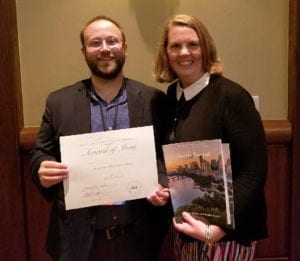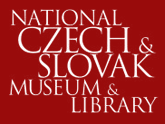By Nicholas Hartmann, Ph.D., Director of Learning and Civic Engagement
This year, the American Association for State and Local History (AASLH) awarded the Leadership in History award to the NCSML for its curriculum and school tour program, Maňa: One Girl’s Story. Considered to be “the most prestigious recognition for achievement in the preservation and interpretation of state and local history,” the program was one of 48 award-winning programs, and the only award winner in 2017 to come from the state of Iowa. Other institutions to receive the award in 2017 included George Washington’s Mount Vernon, Eastern State Penitentiary, and the Indiana State Museum, among many others.

One of the sessions of the AASLH meeting featured several award winners talking about why their projects were relevant and innovative, and how challenges were overcome. Sites talked about topics such as the critical examination of servitude and slavery, the need to include youth and young adults in museum program development, and how to examine human rights issues through historic site interpretation.
For the NCSML, Maňa: One Girl’s Story matters because it tells an immigration story from a different perspective: that of a child who had to immigrate. When Maňa Machovsky Zlatohlavek moved from Kolin, Czechoslovakia, to Cedar Rapids, Iowa, it was not her choice—she went with her family because her father was offered a job. It was out of her control, and people can understand that life is often affected by circumstances beyond our control. Children’s stories make that more realistic, and they can touch on multiple themes: moving, immigration, human rights, and community, among others. By using a blend of oral history interviews, photographs, and other media, as we do at the NCSML, we are teaching students how primary sources tell stories. And through international collaboration, as well as the efforts of Maňa’s family, the story is extensive, personal and multi-faceted. And it can do more than just teach children about immigration.
Beyond the fact that a child’s perspective on immigration is innovative, the personal touches involved in the curriculum—both offsite and on-site at the NCSML—make the project easier for students to connect with. Students meet Maňa, rather just learning about her. They learn about her family, hear some of their stories, and even engage in some of her personal lifeways, such as creating flower art and baking gingersnap cookies at home (from Maňa’s personal recipe). Finally, in Maňa’s story, there are some cases where we don’t know what happened. From the story, kids learn that it is okay to not know something. Hearing “I don’t know” from an adult educator builds a healthy understanding that some stories have gaps that may never be filled.
Those gaps were part of the challenge in developing Maňa: One Girl’s Story, and for two reasons: 1) there were stories from the oral histories that Maňa wished to keep private; and 2) part of the condition for developing Maňa: One Girl’s Story was that the project could not be developed until after Maňa had passed away. The project was nearly 10 years in the making, and according to former NCSML Director of Education Jan Stoffer, waiting for the right moment was one of the most difficult challenges.
According to Jan, “Children in the United States all know that most of us have a family member who came from another country; but, the specifics have been lost over time. I have observed a lack of understanding about immigration and emigration, both here and abroad. Questions as to why someone would leave, what the journey was like, and how an immigrant assimilated in a new country are common. Mana’s story answers some of these questions, while providing opportunity for students to consider what it might be like for them to move to a new country. Additionally, Mana’s story is relevant to European audiences as it explains why some families chose to leave and addresses how immigrants maintained and have infused cultural practices into their new homeland’s traditions.”


1 Comment. Leave new
Terrific honor and much deserved.???? Mana’s story is so relevant to all who enjoy traveling along her journey…. for all ages!! ????